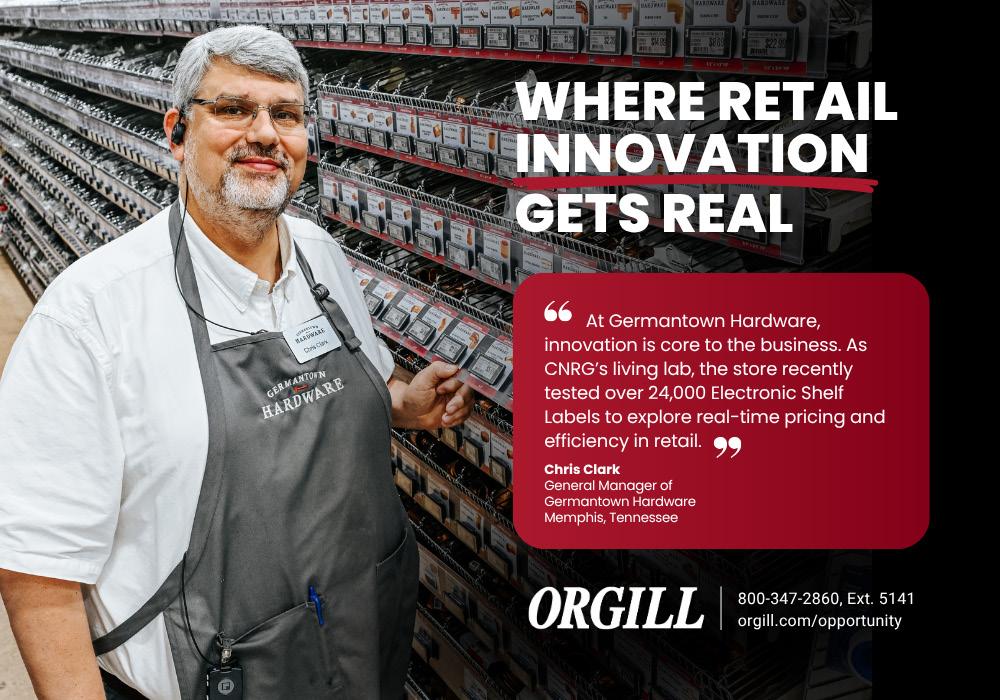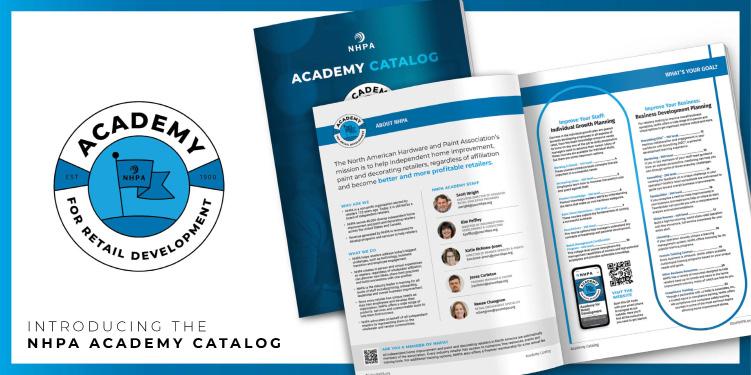






























































































































4 Strategies to Get the Most Out of Your Endcaps Page 10 Smartly Showcase Your Caulk & Tools Category Page 30




















































































































4 Strategies to Get the Most Out of Your Endcaps Page 10 Smartly Showcase Your Caulk & Tools Category Page 30

























































1025 E. 54th St. Indianapolis, Indiana 317-275-9400
NHPA@YourNHPA.org YourNHPA.org
Lindsey Thompson lthompson@YourNHPA.org Managing Editor
Austin Vance avance@YourNHPA.org Manager of Marketing & Partner Relations
Jacob Musselman jmusselman@YourNHPA.org News & Digital Editor
Annie Palmer apalmer@YourNHPA.org Content Development Coordinator
Autumn Ricketts Lead Graphic Designer
Olivia Shroyer Marketing & Design Specialist
Samantha Mitchell Production & Design Assistant
Freda Creech Sales & Production Assistant
ASSOCIATION PROGRAMS
800-772-4424 | NHPA@YourNHPA.org
Cody Goeppner cgoeppner@YourNHPA.org Director of Education & Training
Jesse Carleton jcarleton@YourNHPA.org Training Manager & Editor
Amy Hayes Operations Coordinator—Advanced Education & Training
SALES
Greg Cole
317-775-2206 | gcole@YourNHPA.org National Sales Manager
Jordan Rice 217-808-1641 | jrice@YourNHPA.org Regional Sales Director
Renee Changnon 217-621-7363 | rchangnon@YourNHPA.org Senior Business Development Representative—West Coast
CIRCULATION, SUBSCRIPTION & LIST RENTAL INQUIRIES
CIRCULATION DIRECTOR
Richard Jarrett, 314-432-7511, Fax: 314-432-7665 gcscs8@gmail.com
OUR MISSION
The North American Hardware and Paint Association (NHPA) helps independent home improvement, paint and decorating retailers, regardless of affiliations, become better and more profitable retailers.
Working hand-in-hand with customer service, customer experience in your stores is crucial to creating an environment where customers feel welcome and want to shop. Next month in Paint & Decorating Retailer, we’ll look at the ways retailers can appeal to the five senses in creating a customer experience that will bring customers back again and again.
PAINT & DECORATING RETAILER
(ISSN 1096-6927): Published monthly except December by the North American Hardware and Paint Association, 1025 E. 54th St., Indianapolis, IN 46220. Phone: 800-737-0107. Subscription rates: January through November issues, $50 in U.S., payable in advance. Canada $75 per year. All other countries $100 per year. Single copy $7, except July issue, $25. Periodicals postage paid at Indianapolis, Indiana, and additional mailing offices. Postmaster: Send address changes to Paint & Decorating Retailer, P.O. Box 16709, St. Louis, MO 63105-1209. Returns (Canada): Return undeliverable magazines to P.O. Box 2600, Mississauga, Ontario L4T 0A8. PM# 41450540. Copyright © North American Hardware and Paint Association, 2024.
NHPA EXECUTIVE STAFF
Bob Cutter President & CEO
Dan Tratensek
Chief Operating Officer
David Gowan
Chief Financial Officer & Executive Vice President, Business Services
Scott Wright Vice President of Content Development & Publisher
NHPA BOARD OF DIRECTORS
CHAIRMAN OF THE BOARD
Ned Green, Weider’s Paint & Hardware, Rochester, New York
EXECUTIVE VICE CHAIRMAN
Joanne Lawrie, Annapolis Home Hardware Building Centre, Annapolis Royal, Nova Scotia DIRECTORS
Alesia Anderson, Handy Ace Hardware, Tucker, Georgia
Jay Donnelly, Flanagan Paint & Supply, Ellisville, Missouri
Ash Ebbo, Clement’s Paint, Austin, Texas Christian Herrick, Randy’s Do it Best Hardware, Jackson, Virginia
Michelle Meny, Meny’s True Value, Jasper, Indiana
Michael Sacks, FLC Holdings, LaGrange, Texas
SECRETARY-TREASURER
Bob Cutter, NHPA President & CEO
NHPA CANADA
EXECUTIVE ASSISTANT
Rebekah Doerksen Supply-Build Canada
Direct: 204.953.1692 | Cell: 204.990.3536 Toll-Free: 1.800.661.0253 ext. 103 102-226
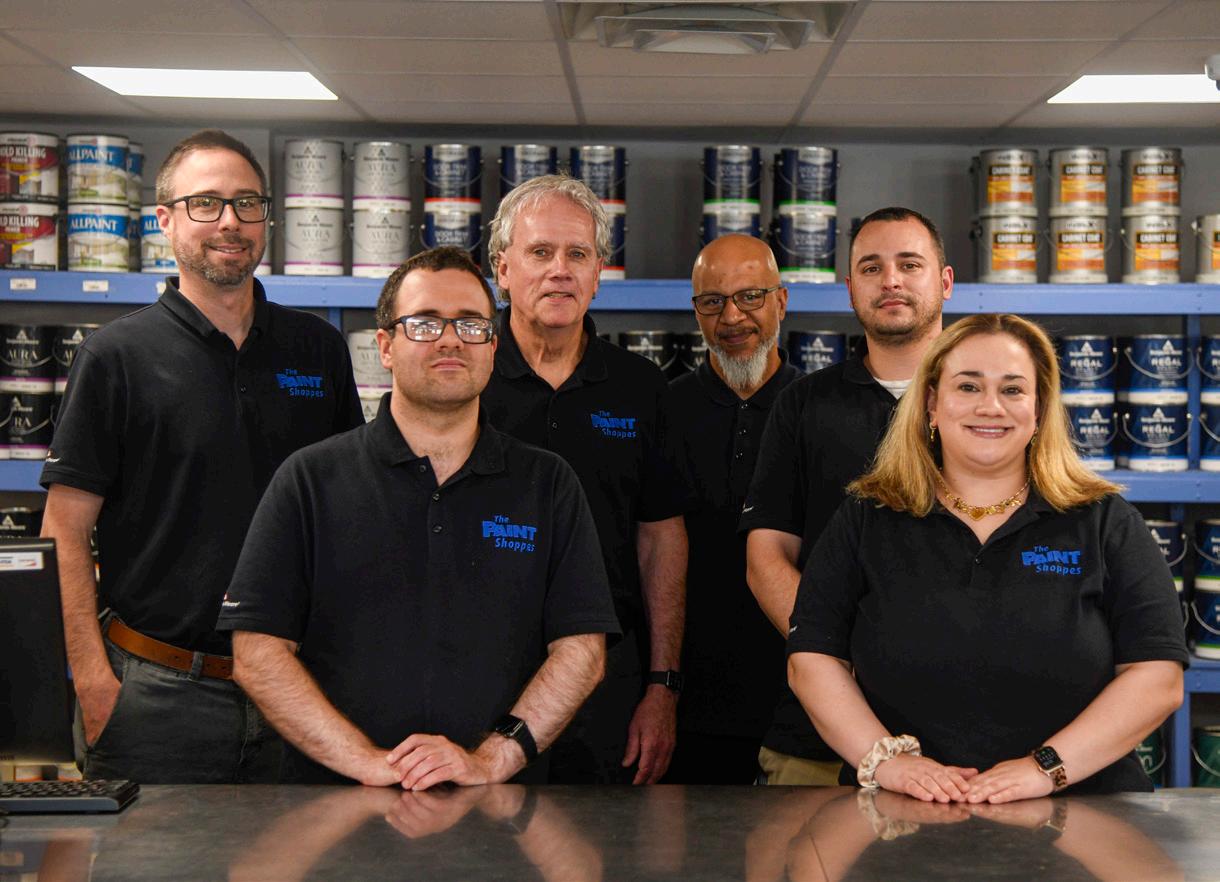
A key piece of real estate in any retail store, endcaps are instrumental for grabbing customers’ attention to increase transaction size and provide sales lift. Hear from several retailers who share their endcap merchandising strategies and best practices.

Leaning Into Learning
When a new employee would join Geerlinks Home Hardware, there was little consistency in training, leading the company to place more emphasis on ongoing education. Learn more how the company’s focus on training has increased not just sales, but employee retention as well.
After a 24-year career in the U.S. Air Force, Andy Horton, this month’s Helmet to Home Improvement honoree, switched gears and started his career in the independent channel, transferring a number of skills from the military to his new role.
Going beyond traditional ransomware or malware attacks, brand impersonation attacks trick users into giving up sensitive data. The Retail & Hospitality ISAC shares the latest trends in these attacks and how to stay protected online.
CATEGORY FOCUS
Learn how one retailer expertly curates their caulk and caulk tools category for both pros and DIYers, focusing on quality, strategic
and customer
to increase sales.
CONNECTIONS
How to Reach Dan Dan
Tratensek dant@YourNHPA.org

SINCE THE 1960 s , Americans with bellies still full of turkey and cranberry sauce have been programmed to rise from their post-Thanksgiving stupors and shamble their way out of the comfort of their homes into the chaos that is Black Friday.
For decades, this single day has become the high-water mark for many retailers, signaling their final push to drive sales before Christmas and the New Year.
As I write this column, the modern stepchild of Black Friday is currently taking place. In just a matter of years, this upstart of an annual exercise in excess has come close to rivaling, if not eclipsing, its relative.
Of course, I am talking about Amazon’s Prime Days. Prime Days typically take place in early to mid-July and was first launched by the online retailer in 2015.
In the 10 years since its debut, Prime Days has continued to grow at a dizzying pace. According to Capital One Shopping Research, in 2024, Black Friday sales amounted to more than $20 billion in the U.S., with about half of that coming from online sales.
In the same year, during the 48-hours of its annual Prime Days sales, Amazon generated $14.2 billion in sales, an increase of 11% from 2023.
Prime Days sales are 400% higher than those during any other typical day for the retailer, according to Capital One, who also shares that small businesses collected about $3.6 billion in sales during the summer promotional period last year.
“Consumers will spend if they are properly motivated, and proper promotions and high-low pricing can still have a major impact on consumer behavior.”
The reason I’m focusing on Black Friday and Prime Days this month isn’t to just toss around some statistics about these major sales holidays. I want to put a spotlight on the fact that consumers will spend if they are properly motivated and to present some evidence that proper promotions and high-low pricing can still have a major impact on consumer behavior.
It seems every year in the days following Black Friday or Prime Days, you’ll hear consumers lament that “the deals just aren’t the same as they used to be.” And while there may be some truth to this, consumers keep chasing the shiny lure that is a well-executed promotion.
So I ask: what are you doing to create this kind of excitement in your trading area? There are plenty of independent home improvement retailers who leverage annual events to drive traffic, sales and generate awareness for their brand. Are you one of them? And if not, why?
Instead of quietly grumbling about the growth of Amazon and gritting your teeth through the spectacle that is Prime Days, you should watch what they are doing closely and learn from it.
You don’t have to generate the same level of Prime Days’ excitement on a national (or international) level like Amazon does, but you can certainly look to replicate some of this energy within your local market.
If you watch how Amazon handles Prime Days, it’s about more than just sales—it’s about creating excitement and uncertainty. It’s about creating a sense of urgency with shoppers to “buy now” and tapping into their desire to discover that special deal.
All of these tactics are things you can do in and around your business. You just have to be willing to be creative, energetic and learn a little bit from a company that has arguably become one of the biggest threats to your business.

Dan M. Tratensek Chief Operating Officer
CONNECTIONS
How to Reach Lindsey lthompson@YourNHPA.org Lindsey Thompson

I LOVE TO BROWSE brick-and-mortar stores. I’m not a big-spender by any means, but I love taking my time walking through the store, seeing what treasures might exist or finding those items I didn’t know I needed (wanted!).
As a suburban mom, my store of choice surprisingly isn’t Target or Trader Joe’s. Rather my favorite stores to browse are any thrift or secondhand store—Goodwill is my favorite choice here in Indiana—and the Dollar Tree.
After writing this month’s feature story on merchandising endcaps (turn to Page 10 to read the full story), I take trips to my favorite stores with a different lens. I’ve always loved shopping at Goodwill, but now I see that the operation’s approach to merchandising is pretty on point. Endcaps at Goodwill will often include a collection of items all in the same color family or that match a theme. More than just a fun way to shop, this strategy grabs my attention and introduces me to items I might not have seen in the aisles.
“Merchandising principles work across the board and are crucial to creating an effective shopping environment that encourages buying and delights customers so they want to continue shopping in your store.”
The same is true at the Dollar Tree—those seasonal endcaps get me every time. I have items in mind I am looking for during my trip, but can’t help but stop and browse the 4th of July costumes, Christmas decor and back-to-school must-haves—more treasures I didn’t know I needed.
I know there are so many other retailers I could have called out for great merchandising. These stores I mentioned don’t always get it right and often have messy shelves, ineffective signage and missing product. But the point is that it doesn’t matter what you sell, how big your store is or who your clientele is. Merchandising principles work across the board and are crucial to creating an effective shopping environment that encourages buying and delights customers so they want to continue shopping in your store. You just need to implement them.
A big thank you to the retailers who shared their best practices for merchandising endcaps. They provide a great starting point or a chance to revamp your own endcap merchandising strategies.
Now excuse me, I have some treasure-hunting to do.
Lindsey Thompson Managing Editor
Sharpen Your Merchandising Tools
Show employees how to create effective project displays to catch customers’ attention. Learn more at YourNHPA.org/trainers-toolbox
Tony Corsberg’s nearly 45-year career began as a stocker at Friedman Bros. Hardware in Santa Rosa, California. He eventually served as vice president of merchandising, where he spearheaded the rebranding initiative that created Friedman’s Home Improvement, which today operates four large-format home centers with lumberyards in northern California. Tony retired from Friedman’s in 2018 and later started his consulting firm Merchant5 Advisors, guiding independent retailers in merchandising initiatives. In 2022, he was integral in the development of NHPA’s Foundations of Merchandising Management program.












One of the most economical ways to increase sales is by increasing the average transaction size of the customers already in the store. Promotional space management is a valuable tool for achieving this, as it contributes to the overarching objective of merchandising management to increase sales, optimize the inventory and maximize the retail selling space performance. Typically endcaps and stackouts are used for items that are being advertised or are new or project ideas, but instead of just filling these spaces, intentional tactics should be established for assortment, pricing and presentation to increase the average ticket size. These positive results were validated in the NHPA’s 2025 Merchandising for Profit Study, which confirmed the management of promotional space increases sales and units sold. Each of the primary promotional spaces provides an opportunity to motivate impulse purchases while customers navigate the store. Here are tips for managing these spaces.
1. Entryway
As the first thing a shopper sees after transitioning through the decompression zone inside the front door, it should greet customers with an impactful presentation of the right merchandise, priced to communicate value and urgency. Don’t greet customers with a random stack of miscellaneous special buys, clearance specials or a service counter. Impress them with relevant merchandise that is priced right.
2. Power Aisle Endcaps, Stackouts, 4-Ways and Dump Bins
The power aisle is a communication superhighway to communicate the retailer’s value proposition with relevant merchandise and value pricing. Don’t overcomplicate the assortment—less is more and one SKU can be best in these spaces. Shout out a great price that is available for a limited time.
3. Sidekicks and Clip Strips
Keep these simple with a single item or price point. Packaging needs to
be recognizable and relevant to the destination product in the area. Price these competitively with a high gross margin percentage.
4. Free-standing Satellite Displays
Be intentional with the placement of these factory-supplied displays. Don’t clutter or obstruct the traffic flow with randomly placed displays—be intentional.
5. Service Counters
Products should relate to the customer’s time at these service counters and be impulse-oriented and priced accordingly. The placement should be intentional, not just clutter on the counter.
6. Checkouts
Queuing checkouts have become very popular. Use 60” tall fixtures to create an easy-to-navigate valley of merchandise such as snacks, incidentals and consumables that appeal to a large audience. Aim for low price points for an easy purchase decision.
The retailers who have intentional strategies with specific guidelines and expectations see positive results. They measure the performance of these spaces and continually improve the execution tactics. These disciplines will increase sales and closure rates, raise the average transaction values and create a more complete shopping experience. The promotional spaces are there, and the products are available. It’s the retailer’s intentional execution that puts it all together.
Tony Corsberg Principle Merchant5 Advisors
OPERATIONS
Top 5 Customer Experience Mistakes
See how to improve service by avoiding key customer pitfalls at PDRmag.com/customer-experience-mistakes
BRICK-AND-MORTAR STORES are still a critical component to retailers’ growth, but a recent study from Jumpmind, a point-of-sale software platform, found that the in-store experience frequently falls short of customer expectations.
The study found that while 85% of retailers say brick-and-mortar stores remain their primary growth strategy, many are still struggling to meet evolving customer expectations. Learn more about the obstacles retailers face to create positive customer experiences.
of retailers say their current POS system is holding them back from innovating their store experience
of retailers cannot view what shoppers buy online to personalize in-store experiences 22% of consumers say their favorite retailer does not offer an exciting in-store experience

























Retailer Recommendations
Send an email to editorial@YourNHPA.org telling us about the products your customers love and why they are a hit in your business.
WERNER LADDER
wernerco.com
The Werner TS1250 is a 12½-foot telescoping extension ladder designed for compact storage and easy transport. It features slip-resistant rungs and a locking mechanism for secure operation. This ladder is constructed from lightweight aluminum, making it suitable for various professional and residential applications.

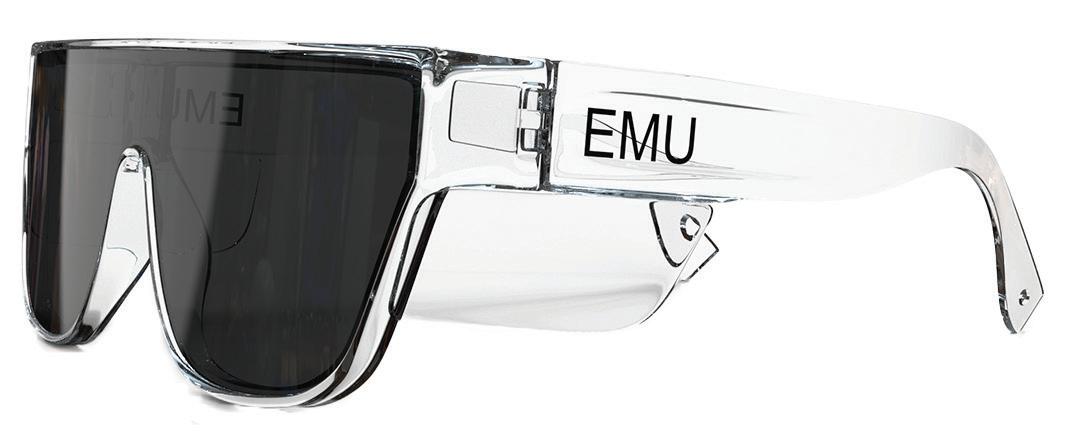
EMU SAFETY emusafety.com
The Boss Clear Frame Safety Glasses from EMU Safety feature a lightweight, impact-resistant design with clear lenses and side shields for full eye protection. They feature anti-fog and anti-scratch coatings and integrated nose pads and temple grips for a secure fit and are rated ANSI Z87.1 for industrial safety standards.
THE WOOSTER BRUSH COMPANY woosterbrush.com
The Flex & Fit paintbrush from The Wooster Brush Company features a flexible soft-grip handle and soft polyester-blend bristles for precise work on trim, edges or flat surfaces. It’s compatible with all paint types and designed to reduce hand fatigue during extended use.





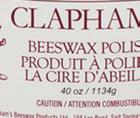

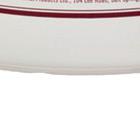





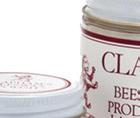
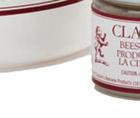





CLAPHAM’S claphams.com


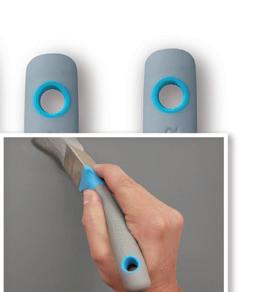


This furniture polish from Clapham’s is a beeswax polish made with the addition of organic carnauba wax to harden the shine and deodorize mineral spirit solvent, which contains no aromatic hydrocarbons. It’s safe, easy to use and gives a delightful shine on wood, stone, marble and concrete.
MOUNTING STRIPS
VELCRO velcro.com
The Workbench Mounting Strips from VELCRO are self-adhesive hook-and-loop strips designed to organize tools and accessories on workshop walls. They hold items securely in place while allowing easy repositioning and tool swaps.

NYLON PATCH
NOSOPATCHES nosopatches.com

MINWAX minwax.com
The Pre-Stain Wood Conditioner from Minwax is a liquid treatment designed to reduce blotchiness and uneven color when staining soft and hardwoods. It penetrates pores for consistent stain absorption and is compatible with oil-based stains.




The Duct Patch from NoSo Patches is a reusable fabric patch for repairing clothing tears and holes. It’s made from ripstop nylon with a heat-activated adhesive. These patches are waterproof, breathable and flexible, designed to blend with garments without stiff edges.

C.H. HANSON chhanson.com




The Wet Paint Barricade Tape from C.H. Hanson is a heavy-duty safety tape made from weather-resistant polyethylene that helps alert passers-by and block off freshly painted areas. It features bold black typography on bright yellow background to enhance visibility per OSHA standards and is 2 millimeters thick, 3 inches wide and 300 feet long.
BY LINDSEY THOMPSON
Literally anchoring store departments, endcaps should be a superstar seller in any store, but require more than just a set-it-and-forget-it mentality. In March, the North American Hardware and Paint Association (NHPA) released its third iteration of the Merchandising for Profit Study, providing detailed insights and data on the impacts of specific merchandising strategies on sales. Of the 13 merchandising techniques studied, five were endcap variations, including a feature endcap with a single item, a feature endcap with a percent off sale sign, a feature endcap with a sale sign, a multi-item endcap main item and multi-item endcap second item.
As an extension of the study, Paint & Decorating Retailer took a closer look at endcap strategies, with NHPA staff visiting several independent home improvement retailers to see their endcaps in action and connecting with others to gain valuable insights on their endcap strategies.
Knowing your market and what customers in your area want and need is another crucial component for endcaps. Rotating endcaps based on the seasons is also important to ensure you’re putting the right products in front of customers at the right time.
At The Paint Shoppes, which has five locations in Rhode Island, owner John McKenna and his store managers—who also collect input from store personnel—plan, put together and manage endcaps in the stores. McKenna and his team create their own endcap planograms based on what their customers need during a certain time of year, and each store’s endcaps vary depending on that store’s customers.


Helpful Input
The Paint Shoppes owner John McKenna uses the experience and knowledge of his managers and other employees to craft each of the stores’ endcaps.
Max Your Space
As a crucial piece of real estate, consider these five ways to make the best use of the endcaps in your store at PDRmag.com/first-class-endcaps

“The new item endcaps grab customers’ attention for those products, but also help draw their attention to go deeper into the aisles to see what we offer.”
—John McKenna, The Paint Shoppes
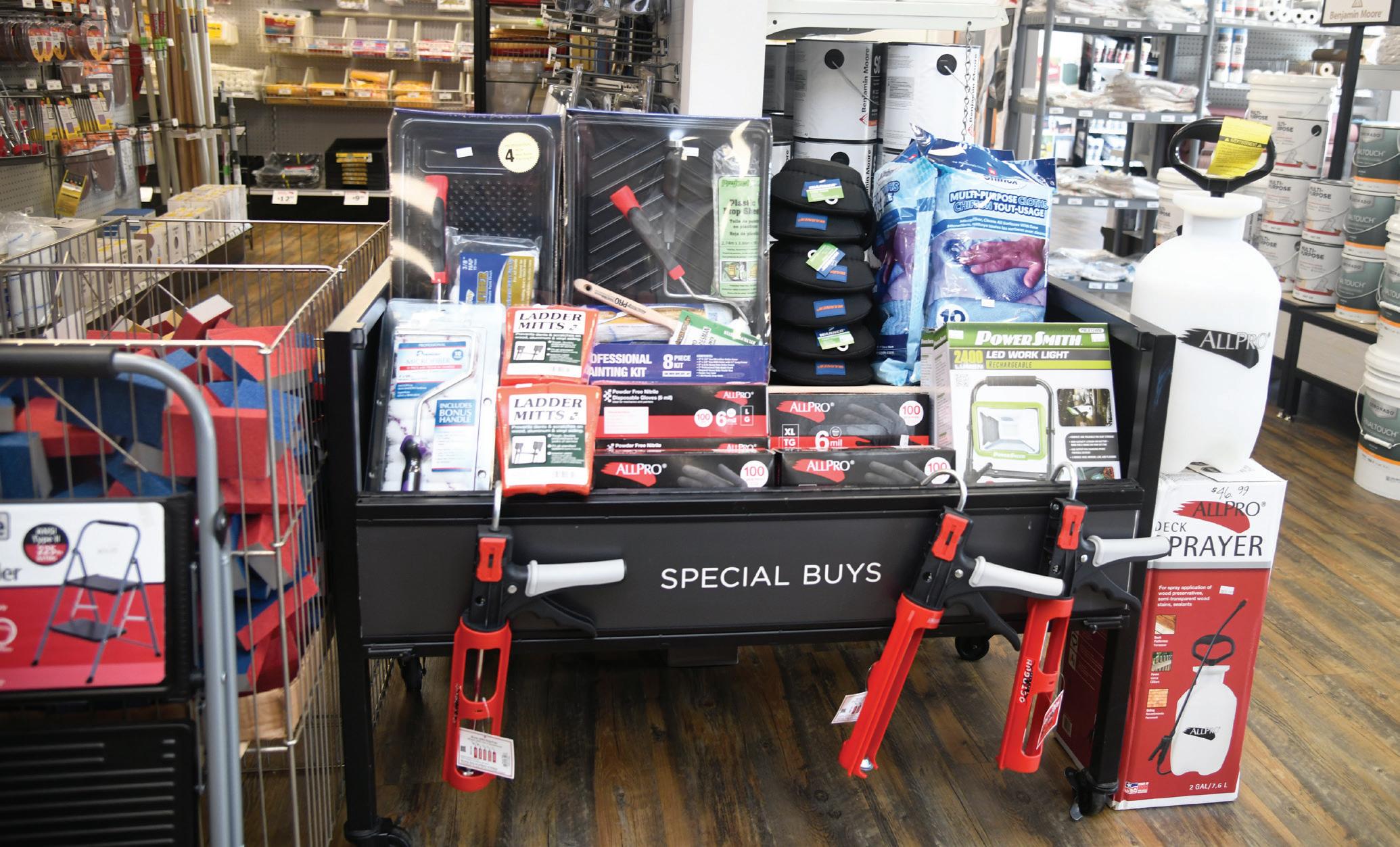
Even though it’s the newest endcap iteration, the most successful endcap has been one McKenna has added to all five stores within the last few months. This endcap is geared to homeowners and offers 20% off project supplies included on the endcap—paintbrushes, rollers, trays and other sundries.
“That endcap has worked really well for us to direct homeowners to all the supplies they will need to go with their paint,” McKenna says. “Everything on this endcap is pretty much what you need to complete your project.”
Along with promoting the products customers need the most, the endcaps are also an effective way to promote new products. McKenna says he has one endcap that is rotated monthly that includes new products and related existing products.
“The new item endcaps grab customers’ attention for those products, but also help draw their attention to go deeper into the aisles to see what we offer,” McKenna says.
Berger Hardware in Hawthorne, New York, utilizes promotions from the operation’s co-op when putting together endcaps, using them as a starting point for crafting endcaps, says Aimee Nichols, who owns Berger Hardware with her brother Chris Rubeo. The wholesaler sends out a monthly execution guide for promotions and the store manager is in charge of executing those promotions through endcaps. Nichols says they follow their wholesaler’s promotions but also build out the store’s endcaps to coincide with the local seasons and the items that are popular in that area during a given time. The team at Berger Hardware will also tweak endcap product selection to maximize sales.
“For example, if there is a promotion from our wholesaler on a certain brand of weed killer, we’ll put that on the endcap but then also add other options,” Nichols says. “Rather than the focus just being on the item on sale, we might put a different option out where we know we’ll get full margin.”
Additionally, they will include add-on products to the endcap’s mix.
“The $4 extra they spend on an add-on item might not seem like much, but increasing transaction size little by little anytime we can is beneficial to overall sales,” Nichols says.
With over 45 years in home improvement retailing, including 15 years as the vice president of merchandising at Friedman’s Home Improvement, Tony Corsberg founded Merchant5 Advisors. Merchant5 is a strategic merchandising service provider that provides merchandising assessments and training in merchandising management.
Corsberg says a retailer should change out endcaps every 30 days, but another option is to establish four to seven seasons, which can include the traditional weather seasons, spring, summer, fall and winter, but can also include additional seasons like holidays, anniversary sales and others.
“Regardless of the promotional space seasons you establish, the promotional spaces should be merchandised up to 30 days before that selling season begins,” Corsberg says.
Utilizing promotions from wholesalers and vendors is one key to success for endcaps. At Grayco Hardware, which has four hardware and home retail stores and four building centers in South Carolina, endcaps center around wholesaler and vendor promotions.
Jon Turner, merchandising manager, says the planning for endcaps starts by identifying items that are going on sale within the operation’s planned promotional window. Grayco plans endcaps utilizing its wholesaler’s promotional program, which makes up about 80% of the stores’ monthly promotions. Turner, along with Donna Ward at the Summerville location, Jack Kerby at the Hilton Head location and Brad Knox at the Lady’s Island store compile the promotions into an Excel workbook and sort through to find items that meet Grayco’s criteria for a good promotion.
“The criteria can look different month to month, or depending on our quarterly goals, but typically we look for products with a strong sales history or active customer sentiment, products that have seasonal demand or impulse potential and products we can receive at least a 10% discount on market price,” Turner says. “Our goal with the promotions is to figure out what the customer

Merchandising expert Tony Corsberg shares the 5 P’s of merchandising and how to utilize them to craft effective endcaps. Learn more at PDRmag.com/5ps-merchandising

wants before they know they want it. If you can anticipate the customers’ needs you can give them a better price, have all the stock they’ll need and provide a better overall customer experience.”
Each month, the team at Grayco changes out at least four of the 30 endcaps in the stores. Because price imaging is important to the operation’s value mission, items featured on endcaps typically are priced at $20 or lower, with some seasonal exceptions such as heaters and pop-up tents. Grayco’s team then works hand-in-hand with its marketing company to be sure these deals are in the monthly flier available in print and online.
While it seems obvious, thinking through what products go on which endcap is also important. There’s no point in having a great deal if customers won’t be exposed to it.
“Placement is crucial for a well-performing promotion; you need to think about how your customer will be shopping,” Turner says.
If done right, promotional and sale endcaps result in customers walking more of your store and bringing traffic to areas they may have otherwise avoided.
“Promotions play a key role in the success of our company,” Turner says. “When combined with a focus on providing the best customer service, offering these promotions and marketing them effectively gives us an edge in a competitive market against the big boxes.”
Price should be the first priority for endcap signage, Corsberg says. In the signage hierarchy, price should be No. 1, product description No. 2 and third should be showing how much the customer is saving.
“And the price should be big. A $2.99 price that is 18 inches tall is a better value than a $2.99 price that’s only 4 inches tall,” Corsberg says “The objective is to shout out value pricing or low price because price today is transparent, and independent retailers can have the reputation for being higher priced than other shopping alternatives.”
Once your endcaps are well-stocked with the right products that promote current sales or appeal to the local market, the right signage can mean the difference between a customer purchasing or walking right by.
At Berger Hardware, promotional endcaps always include the regular price along with the promotional price so customers can see exactly what their savings will be, Nichols says. The endcap signage will also include any instant savings through the store’s loyalty program. Along with including effectual signage, the endcaps at Berger Hardware are thoughtfully placed throughout the store. In 2017, the store underwent a renovation, and Nichols and Rubeo considered how endcaps would play into the store’s updated design.
“When we renovated, we adjusted the aisles to create a clear path taking you down the center aisle where most of our endcaps are located to then draw customers further into those aisles and the store,” Nichols says. “Because our store isn’t a traditional square or rectangle, the endcaps help direct customers through the store.”
Without collecting data and then analyzing that data, it’s hard to know if your current endcap strategies are effective.
At Grayco Hardware, Turner tracks the performance of the promo items, using Microsoft Excel and consolidated sales analysis reports. When he first joined the team in 2023 to focus on merchandising, during the first quarter, the operation brought in an additional $50,212 with an average profit margin gain of 7.83%.
The team accomplished these sales numbers by purchasing three to four months of projected sales at a 10% or better discount and then turned around and gave those savings to the customer during a one-month sale period. They then sold the other two to three months of inventory with the discounted cost for a slight margin gain.
“Any increase to our sales I took as a win considering that before this, we were not taking full advantage of our discounts,” Turner says. “Tracking the data proved to us that sales can be replicated, repeated and will drive traffic if we plan accordingly and offer the right products at the right time.”
At the Paint Shoppes, McKenna runs sales reports on endcaps to see what is performing well and what might need to be replaced with another item.
“While I run the reports, to be honest, we can just tell by just looking at the endcaps,” McKenna says. “When we see certain items flying off the shelf and we are constantly restocking, we know we’re doing something right.”
For the Merchandising for Profit Study, NHPA selected products that lent themselves to the technique being tested. Retailers agreed to leave the items stocked in their in-aisle position, but also stock the product using the featured merchandising technique. Sales were monitored during a 30-day period following the remerchandising. Sales at a similar “control” store for each retailer were also recorded during the same period. The results from test stores and control stores were then compared and the sales lift from each technique were reported and compared to the sales lift percentage from previous studies. To review the full version of this study, visit YourNHPA.org/research/ merchandising-for-profit
Feature Endcap: Single Item
Product Tested: Gas Cans
2025: 109%
2016: 11%
2002: 25%
Multi-Item Endcap: Primary Item
Product Tested: Gas Cans
2025: 29%
2016: 63%
2002: 25%
Multi-Item Endcap: 2nd Item
Product Tested: Fuel Stabilizer
2025: 98%
2016: 63%
2002: 25%
Feature Endcap: Percent Off Sign
Product Tested: Contractor Trash Bags
2025: 125%
2016: 38%
2002: 25%
Feature Endcap: Sale Sign
Product Tested: Weed Spray
2025: N/A
2016: 53%
2002: 25%
BY JESSE CARLETON
If there’s ever a question as to the effectiveness of employee training at Geerlinks Home Hardware Building Centre, general manager Doug Vannoord just points to the numbers.
“We’ve seen sales increases anywhere from 8.7% to 12.7% in every department since we started training,” he says.
As someone who helped implement a training program at Geerlink’s three locations, Vannoord sees firsthand how it makes a difference not only financially, but also in employee retention, morale and customer service. Getting those kinds of results requires investment, careful management and leadership giving their full support to the program.
Prior to 2022, there was not a formalized and consistent onboarding program at Geerlinks Home Hardware Building Centre. The company was missing sales because employees may not have had all of the product knowledge they needed, and were not always crosstrained in multiple departments.
Understanding the need for more consistency in their approach to educating their employees, owners of the company asked Vannoord if he would create a better training path for all employees.
Discover real-life solutions to some of the common problems home improvement operations face with NHPA InFocus case studies. Learn more at YourNHPA.org/research/case-studies
Geerlinks has three locations in Ontario: Geerlinks Home Hardware Building Centre and Design Gallery in St. Thomas; Komoka Kilworth Home Hardware Building Centre in Komoka; and Port Stanley Home Hardware in Port Stanley. There are approximately 225 employees across all locations, with most of them in the 45,000-square-foot St. Thomas store. Managing training for that many people is practically a full-time job, so Vannoord promoted an additional staff member, Kelly Taylor, dedicated to training and HR functions. She uses a spreadsheet to track which courses students need to take and when they’ve taken them.
Every new hire at Geerlinks understands from the start that training will be a major component of their first 90 days. Vannoord says being on the salesfloor eight hours a day during their first few weeks can be overwhelming for a new hire, so he splits their time between four hours of online training and four hours on the salesfloor.
The online training consists largely of product knowledge from the North American Hardware and Paint Association’s (NHPA) courses, including the Basic Training in Hardware Retailing and Basic Training in Building Materials Retailing. Through these courses, employees first focus on the knowledge they need to work in their primary department. Vannoord says they must get their initial batch of training done in their first 60 days, because he wants them to be ready for their 90-day review.
“We rely very heavily on the NHPA courses; that is our foremost source for training,” he says. “Those courses are offered online and once they get through that, managers in each department are responsible for getting people hands-on training.”
Hands-on training is where employees get to handle the product, understand how to use it and understand how to sell it.
New hires are paired with a mentor who is their go-to person for asking questions and discussing what they’ve learned.

The Right Place
Geerlinks Home Hardware Building Centre has a dedicated training room that allows employees to focus on online learning.
Looking to elevate your team’s skills and knowledge? Explore these powerful training resources from the North American Hardware and Paint Association—designed to help hardware and paint retailers grow stronger, smarter and more successful.

Start new hires off right with NHPA’s Onboarding Guide—a practical resource packed with best practices, customizable templates and expert tips for building an effective onboarding program. Whether you’re hiring one employee or a whole team, this guide helps you create a consistent, welcoming and productive start for every new team member.




Empower your managers or experienced staff to become effective trainers with this quick-start guide. It walks you through the essentials of launching an internal training program, from setting learning goals to delivering engaging instruction—so you can keep skills growing from within your team.




Give your entire team access to industry-specific training with NHPA’s Premier Membership. For one affordable annual fee, you’ll unlock a full catalog of online courses covering product knowledge, customer service, leadership development and more—all tailored to the hardware and paint retail world.











After the employee has settled into their specific department, Vannoord begins crosstraining new hires in other areas. He wants every employee to be knowledgeable and confident enough to help customers across multiple departments.
While they will no longer be spending half of their day in the training room, employees still have a curriculum of courses they are required to take. Each employee will be engaged in some type of training year-round, says Vannoord. The biggest push for training is generally September through May, before the busy spring and summer selling seasons. In addition to finishing all of the courses offered by NHPA, employees also take courses in safety, offered by the operation’s wholesaler.
Each store has a training room with two computers where employees can take their training, or they can take it at home. Either way, Vannoord pays for the time spent training. He knows how long it takes to complete a module, so he can keep employees accountable for the time they spend.
Kelly assigns the training curriculum, then it’s up to department managers to carve out time in the schedule for their team to complete their required modules.
Vannoord estimates that Kelly spends approximately 10 hours a week coordinating training. Across the operation’s 225 employees, total time spent training averages about 20 hours each week, which is a small investment considering the return, he says.
In order for training to be effective, it’s important for everyone up the chain of command in the company to validate it. Employees must understand and believe that time spent taking a product knowledge course online or attending a seminar is worthwhile and important to the company and its leadership.
Managers and owners can validate the importance of training by having simple conversations with employees about what they’ve learned, thank them for the effort they put in and find ways to show them you care that they are learning, Vannoord says.
Understanding the importance of reinforcement, Vannoord is strategic in how he assigns training within departments. For example, when employees in the paint department are finished taking the paint-related modules, he begins crosstraining by assigning several of them to the same courses in another category. If they’re all taking a plumbing course, then they can talk about those courses while they’re working, providing another bit of reinforcement to what they’re learning.
“Employees love it when we invest in them, and training is investing in your employees. When we give them the tools to be confident in what they are selling, they’re more comfortable on the salesfloor and they’re happier. And when people are happy, they tend to stay where they are.”
—Doug Vannoord, Geerlinks Home Hardware Building Centre
Vanoorrd suggests managers also take all the training employees are taking so they understand the material, then initiate simple conversations about those training topics.
“Following-up can be as simple as asking, ‘what did you learn?’ or ‘what do you think about what you learned?’
If there’s no interaction between the leaders and the people training, then the person learning may not think it’s worthwhile,” he says. “The leaders must be engaged in training, because if they’re not engaged, then the staff won’t be either.”
Over the past few years, there has been a greater emphasis on having a more formalized training program at Geerlinks. Vannoord, who has the perspective of 15 years with the company, says he has seen clear proof the program has been working.
“In 2022 and 2023, when we first started intentionally training our employees, we purposely didn’t train in one department, just to see what would happen,” he says. “That department, our millwork section, was the only area where we didn’t see a sales increase. Every other area in the store had between 8.6% and 12.6% in sales increases.”


Add-on sales have increased because employees are better equipped to talk intelligently about the products they are selling, Vannoord says. They are also more confident when engaging customers, in large part because of his emphasis on cross training over several store departments.
“For example, along with training our paint employees in paint, we also intentionally train them in the seasonal area, which is right next to the paint
department,” he says. “So when staff in paint see a customer wandering around the seasonal area, they’re not afraid to approach that customer because they know the basics of that department. Instead of hiding in an aisle when they see a customer, employees are engaging our customers.”
Because he knows that training pays off in higher sales, Vannoord says he can justify keeping staff even during slower months of the year.
“Even if we’re at a point where it might make sense to lay off people because business is slow, we’ve been able to justify keeping them on and spending that downtime training because we know that the eventual result will be increased sales,” he says. “We keep people employed and they are grateful, which leads to better employee morale overall.”
Increasing employee retention also cuts recruitment costs, another big payoff for training. He’s also noticed—at least among the younger generation—there is a basic expectation that they will get training when they take the job.
“Employees love it when we invest in them, and training is investing in your employees,” he says.
“When we give them the tools to be confident in what they are selling, they’re more comfortable on the salesfloor and they’re happier. And when people are happy, they tend to stay where they are.”
Conversely, employees who are unhappy or do not feel prepared to do their job successfully are likely to leave. Simply letting them learn on the job without dedicated time for teaching the skills and knowledge they need dooms them to failure.
“For an employer not to train and expect someone to learn on the job is asking for problems and turnover. It’s not good customer service either,” he says.





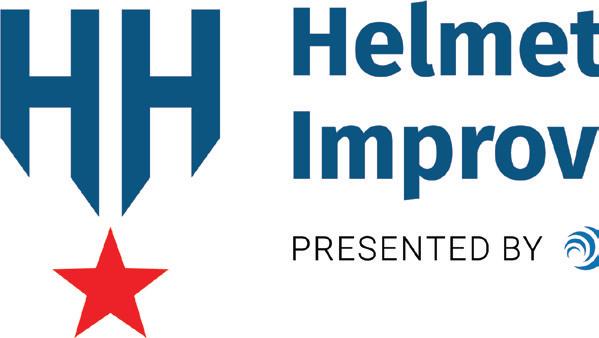

BY LINDSEY THOMPSON
After watching his father serve in the U.S. Air Force for 20 years and growing up in the military community, Andy Horton was determined to follow the same path for his own life. While he achieved his dreams of serving in the military, his journey wasn’t without a few bumps in the road.
“Originally, I wanted to be an F-16 pilot but my lackluster performance in high school created an obstacle for me, so I opted to go to college,” Andy says. “After two years working a full-time job and attending school full-time, my dad saw me struggling and introduced me to a recruiter who used to work for him. That got me started down the road.”

An Honor to Serve
NHPA is sharing the stories of these hometown heroes in all of its media brands. Visit YourNHPA.org/veterans to learn more about these heroes.


While there is no way to repay the sacrifices made by veterans of the armed forces, the North American Hardware and Paint Association (NHPA) recognizes that not only have these individuals made a lasting impact on their country, but they are also a prominent and positive influence within the home improvement industry.
To honor the ongoing impact military veterans make throughout the home improvement industry, NHPA launched the Helmets to Home Improvement recognition program, with the National Hardware Show (NHS) as the program’s official founding sponsor and venue partner.
We need your help honoring these amazing men and women. Please visit YourNHPA.org/veterans to nominate a Helmets to Home Improvement honoree.


Help us honor those who have served our country and our channel. Visit YourNHPA.org/veterans to nominate a veteran from your business to be recognized.
In April 1995, Andy joined the U.S. Air Force and served in active duty continuously until his retirement in May 2019. Starting with basic training at Lackland Air Force Base in San Antonio, Horton attended technical school at Keesler AFB in Biloxi, Mississippi, and served at his first permanent duty station at Yokota Air Base outside of Tokyo, Japan.
During his time in the military, Andy served at Air Force bases across the U.S. in New Mexico, Nebraska, Nevada and Alabama and across the world in Honduras, Greenland, Portugal, Belgium, Turkey, Germany and Italy. He also deployed to Bagram Air Base in Afghanistan from January through September 2018.
When he first entered the Air Force, Andy was a meteorological and navigation (METNAV) systems technician, responsible for the maintenance of weather and navigation systems in support of flight operations.
In the early 2000s, the METNAV career field merged with a large portion of the ground radio specialty, transforming Andy into an airfield systems technician and adding ground-to-air air traffic control communications to his list of responsibilities.



“After about 18 years in this career field, I was selected to attend the First Sergeant Academy. After graduating, I became a first sergeant for the last five-and-a-half years of my career,” Andy says. “First sergeants advise commanders on the readiness, health, morale, welfare and quality of life of the Airmen and their families to ensure a mission-ready force. This job required everything from counseling to giving legal advice to disciplinary recommendations and more.”
During his time in service, Andy says his favorite part of serving was traveling the world learning about and living within many different cultures.
“Even in the war-torn country of Afghanistan, there were great moments, like when I got to share tea with a carpet vendor and learn about his family,” Andy says. “I was stationed in eight different countries and traveled to many more. Each had their own peculiarities, and I enjoyed learning about each of them.”
After Andy retired from the military, the home improvement industry wasn’t a natural first choice. He initially took a year off from anything to decompress and enjoy a slower pace of life after the taxing responsibilities of the military.
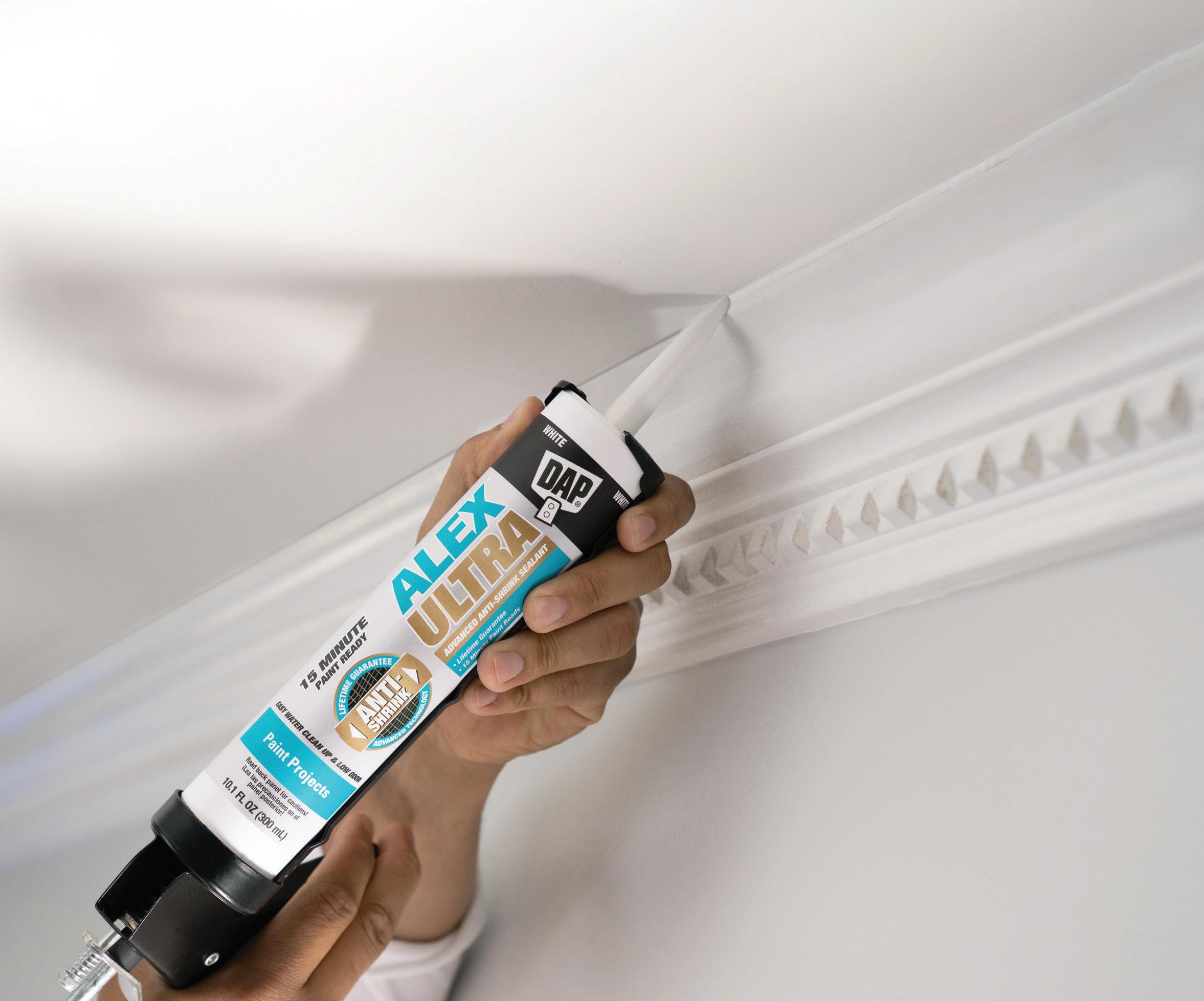

















































“After about a year off, I realized that I spent the majority of my time cleaning my two-bedroom apartment,” he says. “While my apartment was spotless, I thought that there was surely something more productive I could do with my time.”
Horton started searching and applying for jobs online that piqued his interest, and a job at a hardware store caught his eye because it was so different from what he did in the Air Force and a great opportunity to learn a very different set of skills. Andy applied, interviewed and was hired at Ziggy’s Home Improvement in Spokane, Washington, as a loader in the lumberyard.
He was quickly promoted to yard foreman and then transitioned inside the store, working the cashier stand and then the sales counter. For a year, Andy filled in as the


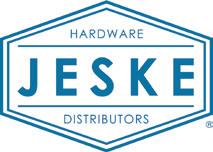

human resources manager and then moved back to the sales counter. Currently, Andy is in charge of keeping the store stocked with merchandise and maintaining the warehouse where excess inventory is stored.
Andy says his favorite part of working in the independent channel is helping customers.
“Every day brings a whole host of customers with a whole host of problems they need help solving. These problems can range from the very simple, like a list of materials, to the very complex, like someone wanting to build a deck with no idea where to start,” Andy says. “I enjoy working through puzzles and really like seeing people leave with smiles on their faces.”





Apex replaces solvent-based varnishes and lacquers, and meets VOC requirements of OTC, OTC II,
and
It provides excellent sandability as a self-seal system along with chemical and wear resistance.




BY LUKE VANDER LINDEN, VP OF MEMBERSHIP & MARKETING, RETAIL & HOSPITALITY ISAC
WITH HIGH VOLUMES of daily transactions and access to customers’ personal data, such as phone numbers, addresses and credit card numbers, retailers are highly targeted by cybercriminals.
Unfortunately, cyberthreats for retailers continue to rise. As brands expand their digital footprints with the addition of new services and systems, the attack surface for would-be hackers also expands, creating more opportunities to do harm.
These days, bad actors are going beyond traditional ransomware or malware attacks. Instead, they are launching
brand impersonation attacks, posing as retailers online to trick customers into making purchases or giving away sensitive data. For retailers, the consequences are far-reaching, from operational downtime and lost revenue to potential regulatory fines or even lawsuits. Moreover, brand impersonation attacks sour customer trust and damage reputations—intangible but profound effects that can take years to reverse.
Here’s a look at the latest trends in brand impersonation attacks and what you can do to protect your brand online.
Read more insights from RH-ISAC on how you can make cybersecurity a core part of your business strategy at PDRmag.com/cybersecurity-strategy
One of the most obvious ways cybercriminals impersonate retailers online is by setting up shop with a fake domain that’s a look-alike of the store’s real website. By securing a domain with just a slight variation of the brand’s real web address, bad actors can create copycat websites that trick customers into thinking they’re browsing their favorite brands. Mimicking the company’s logos, colors and other branding adds to the facade. Likewise, fraudsters can easily set up social media profiles that mimic retailers or top product lines. Another increasingly common
tactic employed by bad actors is sending emails that purport to be from a retailer and offer deep discounts or other compelling offers to drive traffic to a fraudulent website.
Under this guise of authenticity, cybercriminals can get customers to willingly input personal information, such as credit card numbers or addresses, all while believing they’re making a legitimate purchase or booking a room for an upcoming vacation. Criminals can further sweeten the pot by advertising huge discounts, fake “store-closing” sales, loyalty points and other incentives to lure in customers and get them to hand over their data.

The Retail & Hospitality Information Sharing and Analysis Center (RH-ISAC) is the trusted community for sharing sector-specific cybersecurity information and intelligence. The RH-ISAC connects information security teams at the strategic, operational and tactical levels to work together on issues and challenges, to share practices and insights and to benchmark among each other—all with the goal of building better security for consumer-facing industries through collaboration.
All members of the North American Hardware and Paint Association (NHPA) are eligible for a free trial membership to RH-ISAC. During Cybersecurity Awareness Month and throughout the rest of the year, RH-ISAC offers weekly threat-briefing conference calls, discussion groups focused on a wide range of topics and in-person training and professional development opportunities. Visit rhisac.org/nhpa to sign up for a trial membership and to access free resources, including a small business toolkit to reduce cyber-risk.
As artificial intelligence and deepfake technology make it increasingly difficult to discern what’s real and what’s fake online, brand impersonation attacks will continue to rise. But while the consequences for retailers are stiff, not all are prepared to withstand such threats.
So, what can be done to keep hackers from duping customers with brand impersonation tactics?
To prevent phony websites, brands can secure domain names similar to theirs. It’s also wise to scoop up look-alike social media handles and usernames to prevent fake accounts from cropping up. Retailers can also lean on brand protection software that helps search for and even take down counterfeit websites.
The Best Defense Is Collaborative Intelligence
Software can only do so much in the face of rising brand impersonation attacks. Even the Federal Trade Commission issues a warning, calling out business impersonation scams as one of the most commonly reported scams. In total, the agency fielded more than 300,000 reports of business impersonation scams for a combined loss of more than $1 billion.
It’s simply impossible for one organization to stay on top of all ongoing threats, even with the support of software. That’s why the best defense against brand impersonation attacks is collaborative intelligence. By working with other retail organizations, you can rapidly share information about new attack strategies and vulnerabilities to take action fast and prevent attacks before they occur.
For help warding off brand impersonation attacks, retailers specifically can turn to RH-ISAC, a retail- and hospitality-focused cyber intelligence community. This global consortium connects information security teams at the strategic, operational and tactical levels to share best practices, benchmark against each other and work together on common cybersecurity issues.
Cyberattacks are nearly ubiquitous and hackers are getting craftier, but by working together, retail and hospitality organizations can maximize threat intelligence and build better security for the entire industry.
“It’s simply impossible for one organization to stay on top of all ongoing threats, even with the support of software. That’s why the best defense against brand impersonation attacks is collaborative intelligence.”
—Luke Vander Linden, Retail & Hospitality ISAC
BUSINESS FOR SALE
Northwest Farm & Home Supply Co.
Location: Lemmon, SD
Gross Revenue: $3.21 million
The main building is a total 27,213 sq. ft. of retail and warehouse space on 4 acres. The main bldg. was constructed in 1994 with additions constructed in 2002 and 2004.
Single story with 22’ clear height in 11,459 sq. ft. of lumber warehouse, three grade level doors and two dock height doors.
BUSINESS FOR SALE
Hoosick True Value
Location: Hoosick Falls, NY
Gross Revenue: $1.26 million
Price: $1.875 million
This opportunity offers a turnkey sale of a general hardware business located in northeastern Rensselaer Co., New York. The business serves five towns and southwestern Bennington Co., Vermont, and 25 miles east of Troy, New York.
SEEKING BUSINESSES
The Aubuchon Company
For our next acquisition, we are looking for:
• Single-store and multi-store hardware operations
• Located in northeast and southeast United States
• Store size of 5,000-30,000 ft 2
• At least $3 million in average store sales
SEEKING BUSINESSES
BUSINESS FOR SALE
Home Improvement Supply Store
Location: Missouri
Gross Revenue: $1.04 million
This historic home improvement and hardware store is a staple of its community and operates from its headquarters in the Kansas City Metropolitan Area of Missouri. The Company is a long-standing retailer and installer of consumer and commercial improvement products.
BUSINESS FOR SALE
Albrights Hardware & Garden Center
Location: Allentown, PA
Gross Revenue: $1.9 million
Price: $800,000
Albrights Hardware is an established hardware store with strong neighborhood ties and has been a Lehigh Valley staple for over 50 years. The current owners have owned the store since 1992. Albrights serves its loyal customer base by providing quality products and exceptional customer service.
SEEKING BUSINESSES
Bolster Hardware
We are looking for:
• Geography agnostic
• With or without real estate
• Store revenues of $1.5M+
• We prefer to honor the family name and heritage in the local community by not changing the name
• We prefer to keep all employees as part of the acquisition
JOB LISTING
The Helpful Hardware Company
We are looking for:
• Single-store units in the southeast and multi-store groups with 3+ units nationwide
• Store size of 5,000 ft2-35,000 ft2
• Supplier agnostic
• Store revenue: $1.75M+
BUSINESS FOR SALE
Central Vermont Paint, Flooring and Decorating Business
Location: Vermont
Gross Revenue: $2.82 million
Price: $1.1 million
Full-service decorating store providing flooring, paint, window treatments, kitchen/bathroom remodeling, cabinetry product offerings, design assistance, specialized service, and professional installation.
BUSINESS FOR SALE
Private Business
Location: Alabama
Gross Revenue: $2.21 million
Price: $649,000
BUSINESS FOR SALE
Private Business
Location: Pennsylvania
Gross Revenue: $1.6 million
SEEKING BUSINESSES
Gold Beach Lumber Yard
We are looking for:
• Single-store and multi-store hardware operations
• Located in the Pacific Northwest
• Store size of 5,000 ft2-30,000 ft2
Randall Lumber & Hardware, Inc.
Position: Hardware, Ranch and Feed Department Manager
• Annual Salary: $48,000-$55,000
• Bachelor’s Degree or 5 years of experience in similar role preferred
• Strong leadership skills and creative thinking are a bonus

The Right Tools
, manager and buyer at Town
, knows how to expertly merchandise the caulk and caulk tools section in his store with his 25 years of industry experience.

See how other retailers make the most of their merchandising at PDRmag.com/merchandising-drives
HOW TO EXPERTLY MERCHANDISE YOUR CAULK AND CAULK TOOLS SECTION
BY ANNIE PALMER
For many contractors, caulking is like a second arm—an item many can’t work without. DIYers are also in need of caulk products, but often need direction to know what to buy. While caulk and caulk tools are small categories by size in many paint and decorating stores, this department can make a significant impact in sales volume when curated effectively for pros and DIYers.
At Town Line Wallpaper and Paint in Malden, Massachusetts, manager and buyer Gerard MacNeil’s 25 years of experience has provided him the knowledge and skill to expertly merchandise this category. MacNeil shares how he sells caulk and caulk tools in his store and how other retailers can better showcase these products.
With an overwhelming amount of caulk, caulk guns, tools, accessories and removal products on the market, choosing the right item can often be intimidating for customers. Providing the highest quality products and not confusing customers with a dizzying array of choices is important to MacNeil and his customers.
Town Line Wallpaper and Paint carries just a few lines of caulk from select vendors the operation has strong relationships with. MacNeil only purchases around $50,000 worth of caulk per year, not including caulking accessories or tools.
The store also carries three to four caulk gun varieties.
“We sell a tremendous amount of caulking guns,” MacNeil says. “We sell removal tools and accessories too, but caulking guns are our No. 1 bestsellers apart from the caulk itself.”
MacNeil works to ensure his customers are educated about the quality of a caulk or caulking product before purchasing.
“Most painters are going to choose a caulk usually by price, not necessarily by what the application is trying to achieve,” he says. “Some contractors will always default to the cheapest caulk and you can have some issues with that down the road, so we encourage them to look at the better products we offer.”
Aiming to prevent decision paralysis among customers and educating them about each product, MacNeil markets many of his caulking products with a good, better, best model. This allows customers to easily see the differences in performance and quality for each item, giving them the opportunity to learn about the options and choose the most practical one for their job.
“I’m not making it too confusing for the customer,” he says. “Having a good, better and best option seems to work well for us. I know some stores have a gazillion different options. I even see that when I go to order products because there are a million brands out there.”
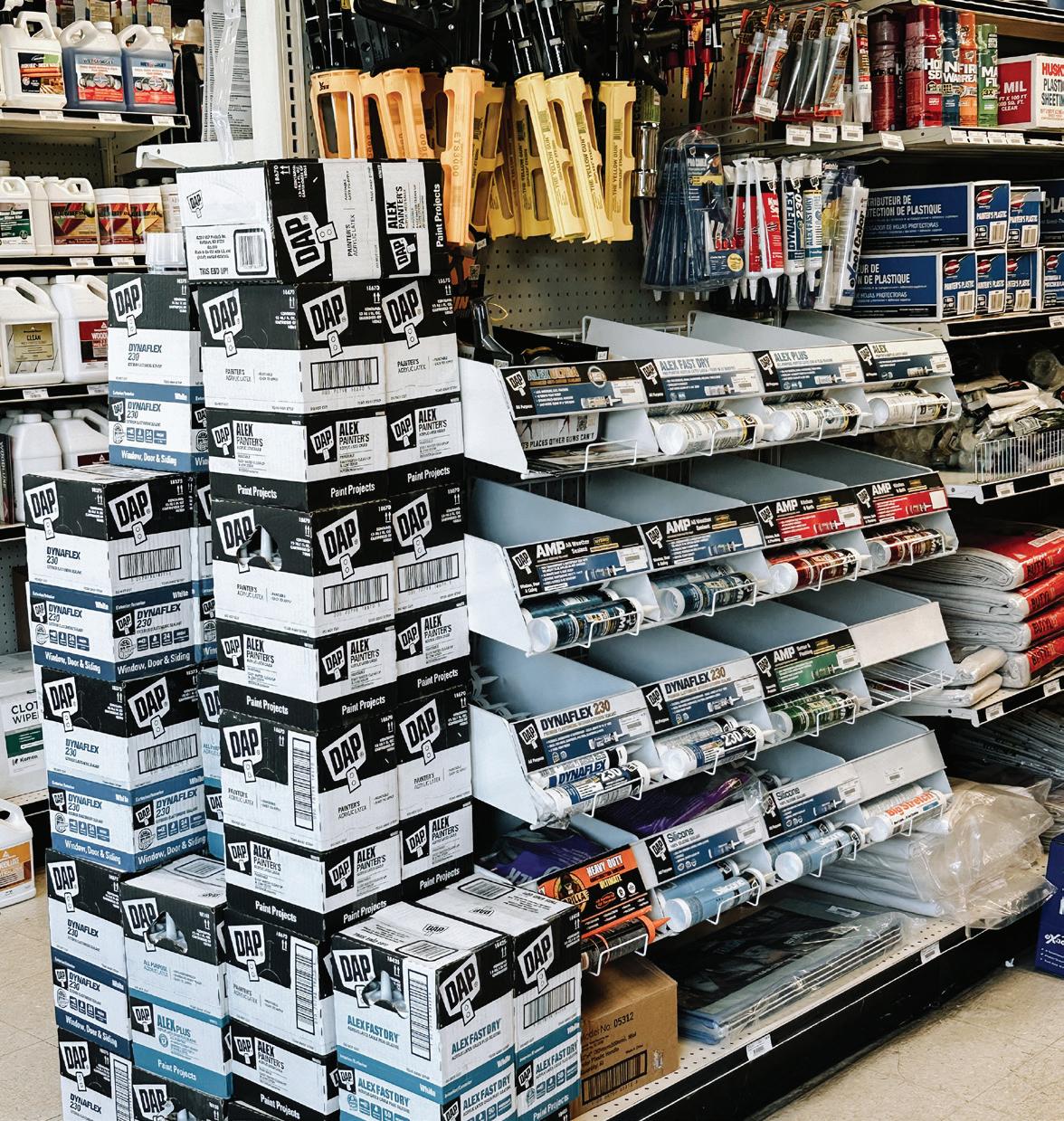
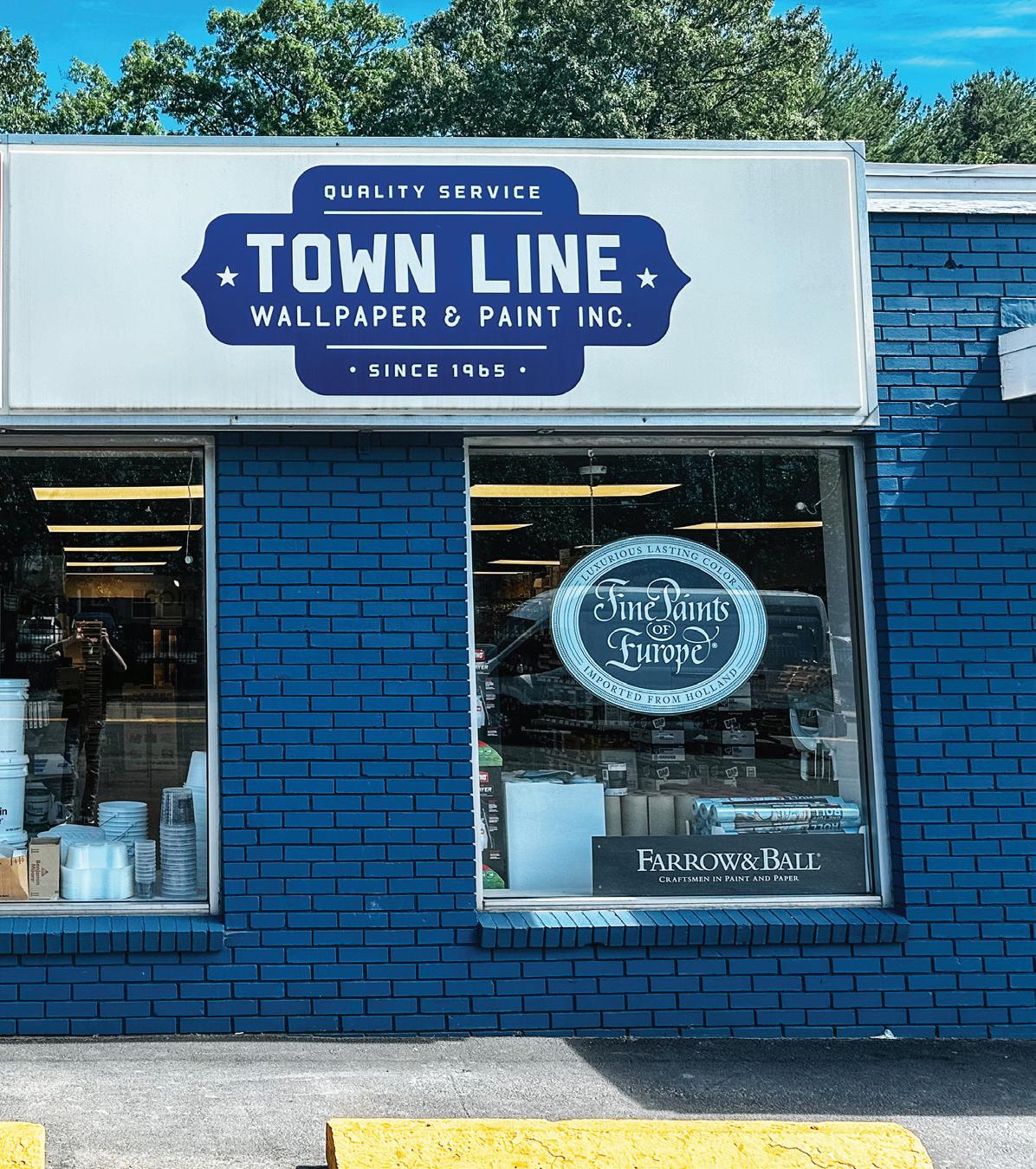
When considered for painting projects overall, caulk is purchased more often when homeowners are preparing to do an exterior painting project (36%) versus when preparing to do an interior painting project (22%) based on findings from HIRI’s 2023 Project Decision Study
For contractors or homeowners looking to caulk exterior painting projects, make sure you’re selling the correct types of caulk for your climate. If your area tends to have a lot of moisture, recommend a caulk that is mildew resistant. If your area has high winds, recommend a flexible caulk.
Silicone and polyurethane acrylic caulk are both popular choices for outdoor projects due to their resilient and temperature-forgiving properties. Polyurethane caulking can last up to 10 years and silicone caulk holds for upwards of 20 years, according to Fastener Systems.
Selling strategies for caulk and caulk tools is similar to selling impulse items. The key to showcasing this product to the best ability is placing it in clear view for the customer at the entrance of the store.
“Product placement is key,” MacNeil says. “If you’re a paint contractor walking into a paint store and you do this professionally for a living, or even a homeowner working on a project, you should have a tube of caulking. It almost seems to be an impulse item. It took us some time to figure out, but putting it exactly where it is in my store now has worked wonders for us.”
Town Line has multiple power aisles which are shelf-lined walkways filled with high-impact paint necessities that lead straight to the store’s cash register at the back of the store, MacNeil says. The store’s caulking selection is located near this aisle, allowing customers to see these products right away.
“This category is something that needs to be out in the open,” he says. “You don’t put it in aisle three. We found putting caulking products within the first 15 feet of the store works the best for us.”
In addition to strategic product placement, customers are more likely to purchase items if they can see how they work in person in the store. MacNeil likes to include caulking product demonstrations in his store, and recommends other retailers do the same.
“Some of our vendors provide nice endcap displays and we have a demonstration with some product applied under a backer rod hanging off the channel strips on the shelves,” he says. “Once a customer can touch it, feel it and see it, they can fully understand the product. It’s a guaranteed sale every time.”
“This category is something that needs to be out in the open. Once a customer can touch it, feel it and see it, they can fully understand the product. It’s a guaranteed sale every time.”
—Gerard MacNeil, Town Line Wallpaper and Paint
Subscribe to our weekly newsletters at PDRmag.com/subscribe to get the latest news and trends.
The Merit Distribution Group LLC and its subsidiaries completed a sale transaction with Spartan ParentCo LLC, an affiliate of Czech Asset Management. While Merit Distribution will operate under new ownership, existing operations and management will remain unchanged.
The Home Improvement Research Institute (HIRI) revised its 2025 growth forecast downward to 3.4% from 5%, as the $574.3 billion home improvement market faces sustained economic headwinds, including rising costs, tariffs and housing market challenges.
The Building Materials Careers Association of North America (BMCANA) launched in July and will be dedicated to addressing the talent shortage in the building materials industry, making the sector North America’s most desirable career destination by 2030.
PPG showcased its latest innovations to members of the analyst community at the company’s global Coatings Innovation Center in Allison Park, Pennsylvania. The event focused on exhibiting the company’s focus on sustainability.

Import cargo volume at the nation’s major container ports is expected to bounce back this month after a significant decrease in late spring, but is expected to fall again after previously paused tariffs take effect, according to the National Retail Federation and Hackett Associates’ Global Port Tracker.
The Sherwin-Williams Company announced it will continue as the official paint partner of Leagues Cup and shared an enhanced fan engagement strategy for the event. Leagues Cup 2025 will take place this summer and feature clubs from Major League Soccer and LIGA MX.
To read these news stories and other news, visit PDRmag.com/industry-news
AUG
Orgill Fall Online Buying Event
August 4-17 | VIRTUAL
The Garden Center Show August 12-13 | ROSEMONT, IL
Ace Fall Convention August 12-14 | CHICAGO, IL
SEPT
Do it Best and True Value Fall Market
September 5-8 | INDIANAPOLIS, IN
PACOA – Fall Dealer Market
September 6-7 | FLUSHING, NY
Bradley Caldwell Fall Show
September 9-11 | ATLANTIC CITY, NJ






















INDUSTRY EVENTS
All the Highlights
For all things 2025 Independent Home Improvement Conference, head to PDRmag.com/2025-ihi-conference-roundup
Bringing the independent channel together in Orlando, Florida, the 2025 Independent Home Improvement Conference (IHI Conference) combined learning and leisure, sending attendees home with best practices on retail operations and insights to address current market conditions. Attendees of the event, hosted by the North American Hardware and Paint Association and the Hardware Conference, included retailers from all
affiliations, industry vendors and other channel players, who enjoyed educational breakout sessions, networking opportunities, keynote speakers and social events.
Keep an eye out for the September issue of Paint & Decorating Retailer, which will feature a full recap of the event, including a celebration of the Young Retailer of the Year honorees, and check out the IHI Conference by the numbers below.


















Flood Easy Seal is a premium oil-based wood finish + sealer that provides a beautiful finish with a flawless one coat application.
Designed with a streak free performance that results in no runs and no laps, Flood Easy Seal is an easy-to-use formula to get your woodcare project done faster. Available in 8 ready-mixed colors, it’s recommended for decks, fences, siding and other outdoor wood surfaces.
• One-Coat Application
• Penetrates Deep for a Flawless Finish
• No Runs, Laps or Back-Brushing
• 8 Ready-Mixed Colors
• No Cracking, Flaking or Peeling
:
• UV Blocking
• Water Resistant
• Fortified with PENETROL® for Excellent Penetration
• Recommended for: Decks, Fences, Siding and other Outdoor Wood Surfaces






